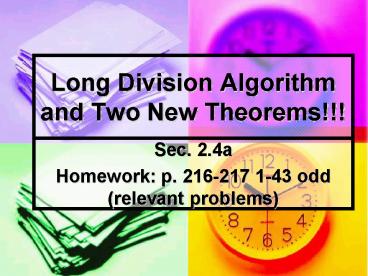Long Division Algorithm and Two New Theorems!!! - PowerPoint PPT Presentation
1 / 11
Title:
Long Division Algorithm and Two New Theorems!!!
Description:
k is a zero of the function f. 3. k is ... Using Our New Theorems Find the remainder when the given ... Using Our New Theorems Use the Factor Theorem to determine ... – PowerPoint PPT presentation
Number of Views:95
Avg rating:3.0/5.0
Title: Long Division Algorithm and Two New Theorems!!!
1
Long Division Algorithmand Two New Theorems!!!
- Sec. 2.4a
- Homework p. 216-217 1-43 odd (relevant problems)
2
First, lets work through this
We can write our answer as
We use a similar process when dividing
polynomials!!!
Remainder!
3
Division Algorithm for Polynomials
Let f(x) and d(x) be polynomials with the degree
of f greater than or equal to the degree of d,
and d(x) 0. Then there are unique polynomials
q(x) and r(x), called the quotient and remainder,
such that
where either r(x) 0 or the degree of r is less
than the degree of d. The function f(x) is the
dividend, d(x) is the divisor, and if r(x) 0,
we say d(x) divides evenly into f(x).
Fraction form
4
Using Polynomial Long Division
Use long division to find the quotient and
remainder when is
divided by . Write a
summary statement in both polynomial and fraction
form.
? Quotient
? Remainder
5
Using Polynomial Long Division
Use long division to find the quotient and
remainder when is
divided by . Write a
summary statement in both polynomial and fraction
form.
Polynomial Form
Fraction Form
Can we verify these answers graphically???
6
And Our Two New Theorems
Theorem Remainder Theorem
If a polynomial f(x) is divided by x k, then
the remainder is r f(k).
Theorem Factor Theorem
A polynomial function f(x) has a factor x k if
and only if f(k) 0.
7
Fundamental Connections for Polynomial
Functions
For a polynomial function f and a real number k,
the following statements are equivalent
1. x k is a solution (or root) of the equation
f(x) 0.
2. k is a zero of the function f.
3. k is an x-intercept of the graph of y f(x).
4. x k is a factor of f(x).
8
Using Our New Theorems
Find the remainder when the given function is
divided by (a) x 2, (b) x 1, and (c) x 4.
(a)
(b)
(c)
Because the remainder for part (c) is zero, x 4
divides evenly into the function. So, x 4 is a
factor of the function, and 4 is an x-intercept
of the graph of the function
(we know all this without ever dividing,
factoring, or graphing!!!)
9
Using Our New Theorems
Use the Factor Theorem to determine whether the
first polynomial is a factor of the second
polynomial.
Check f(3)
Yes, x 3 is a factor of the second polynomial,
because f (3) 0
10
Using Our New Theorems
Use the Factor Theorem to determine whether the
first polynomial is a factor of the second
polynomial.
Check f(1)
No, x 1 is not a factor of the
second polynomial, because f (1) 2
11
Some whiteboard problems































